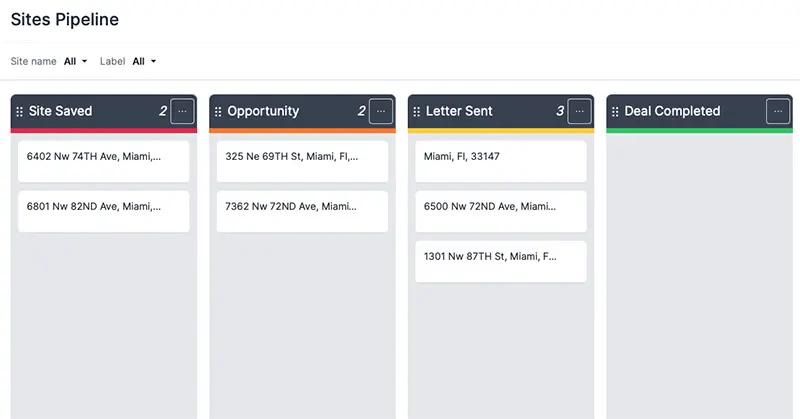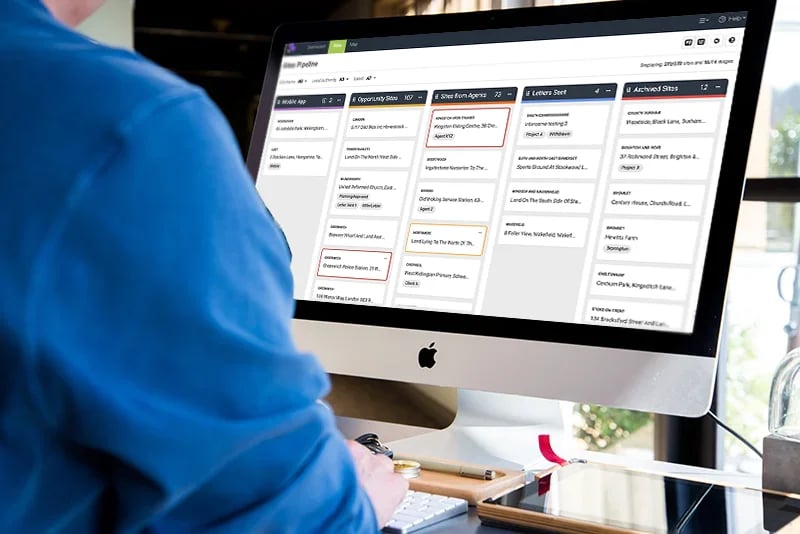Sourcing opportunities is often seen as the most important part of the development process, but being able to monitor and manage your pipeline is equally as vital to guarantee the success of your projects.
Written down notes, and a plethora of spreadsheets may work in the short term to help you manage your property development pipeline. But they may not be the most efficient way for you to track opportunities.
We take a look at why property development pipeline management is so important – and share three tips for you to set yours up for success.
What is property development pipeline management?
Often in property, you’ll be juggling multiple different projects that will be at varying stages of the development lifecycle. Sites pipeline management is the act of tracking and organizing the progression of all your projects.
For example, it can be a lengthy process getting development approvals (particularly for larger developments) so you don’t want all your projects to be stuck at this stage, otherwise, you may not be able to break ground on any.
Therefore, managing your pipeline of sites is key to ensuring you’re staying on top of the status and any actions required for your projects. Below, we share more reasons why property development pipeline management is so important for developers.
Why is property development pipeline management important for developers?
Property development pipeline management is critical to ensure that projects are moving along at the pace required. Projects need to be strategically staggered to protect cash flow and optimize your ROI.
Especially when the timelines of projects can be long, you need to ensure that you always have the next development ready to go. Plus, have visibility on what’s needed to get it to the point of approval, construction, and sale.
After all, there’s no point spending all that time finding suitable sites, only to mismanage the tracking and progression of them through the various stages of your pipeline.
Organization may not seem like the most exciting part of being a developer, but it is important – and with the right tips and tricks it can be a lot easier.

How to manage your property development pipeline more effectively
Below, we’ll take a look at the three tips you can implement to set your property development pipeline up successfully:
1. Establish clear project goals and timelines
When setting up your property sites pipeline tracker, it’s good to decide on what goals and objectives will be used to define the different stages of your pipeline.
For example, if sending four sequenced letters to the landowner of every site of interest is part of your workflow, you should set up a separate stage for each letter so you can easily keep track of these personalized communications and mark them off once completed.
Next, you’ll need to set realistic timelines for when you want to reach each of these milestones – breaking each stage of the development into manageable chunks with achievable deadlines.
Obviously, every development is different and last-minute complexities or hurdles can cause timeframes to bloat. However, if delays do crop up, having a set template that can be adjusted will prevent you from needing to create a bespoke workflow each time, and ultimately, save you time.
Finally for tip one – it’s important not just to set it and forget it. Continually monitoring whether the set up of your development pipeline is working will help you optimize your approach.
Proactively gather feedback from your team to see if there are tweaks that can be made to cut down time spent on a particular stage.
Open and ongoing communication is critical for effectively managing your sites pipeline.
2. Visualize sites and target areas
Excel sheets and stacks of paper can show you what stage of the development process all your projects are at. However, they don’t show you where all your sites are in relation to each other. Or at least, this data can’t be populated automatically and requires a lot of manual work on your side.
You can use a sites pipeline tool to group opportunities in key target areas, and instantly see on the map where they are in relation to each other.
Visualizing your sites on a map can help you spot geographic patterns – such as, is construction faster to get underway in certain neighborhoods?
Not only does this data help you to set up and review your development pipeline, but it helps you to plan for the future and plot which areas would make the most sense to target.

3. Embrace technology and automation
Even with the best organization and channels of communication, human errors can happen and disrupt your system.
A sites pipeline management system – sometimes called a property pipeline management tool – can help to simplify and automate the process.
There are a lot of benefits to using a sites pipeline management tool, such as:
- Instantly see a clear overview of all your projects
- Monitor project progress and performance
- Easily search and filter your sites
- Collaborate with your team on merged pipelines
However, the key reason why lots of developers lean on technology in pipeline management is that it takes a lot of the manual work out of your hands. You’ll have more time to focus on other steps of the development process and get your project (and profit) over the line faster.
How can LandTech help?
We empower you to manage your property development pipeline with ease.
Even better, you can find, assess, and manage opportunities all within LandTech. See a site you like in the map view? Simply click save and add it to the relevant stage in your sites pipeline. This connection between the map and pipeline lets you have a clear overview of where sites at any stage of the development process are situated – and means you don’t have to navigate to another tool to get this visualization.
The saved sites area lets you and your team view and track the status of all your developments in one place. No more juggling multiple lists, spreadsheets and different platforms – you now have everything you need within one easy-to-use platform.
Your sites area is fully customisable so you can add in whatever site stages are relevant to your way of working. As well as color code and label sites to add any extra layers of detail.
Share all this with your team through our merged pipeline feature and assign a colleague a specific stage or site to handle.
You can also print or download the site report as a PDF to present to other relevant stakeholders.
We also have multiple views you can play around with so you can figure out the best way of working and getting visibility over all your sites.
And if you’re worried about losing data that you have stored in another tool, do not fear. We do offer a Concierge Service on a case by case basis that lets you import any existing sites into your sites pipeline into LandTech.
Ready to ditch the spreadsheets?
Find out how our site sourcing and management features can help you level up your development processes.
Find out more